
In July 2022, central and southern Europe were hit by a heat wave and drought. Instead of traveling to Greece and Albania as planned, we changed our travel plans at short notice and headed north: After we had repacked our Dark Zebra, the name of our black TD4 SVX from 2009, from weekend luggage to holiday luggage, we set off the next morning:
Bright and early at the ungodly hour of 6:30 a.m., my lovely wife Rose decided to play the role of the human alarm clock and jolted me awake from the sweet embrace of sleep. Her reason? The pesky sunshine was rudely interrupting her beauty sleep. With a mix of excitement and sleepiness, we hastily gathered our belongings and embarked on our journey towards the great unknown of the north.
First things first, we kicked off our adventure heading towards Hamburg! Despite the scorching heat, the road trip was surprisingly enjoyable, probably because the air conditioning was actually working for once. And then, our dear friend Clauthilde, who out of the blue would show up in our house unannounced, resided in Hamburg. It was time for revenge! So, in a cheeky message sent en route, we informed her of our imminent sofa invasion and slyly inquired if she was even in town. To our delight, she welcomed us with open arms and treated us to a feast fit for kings - sushi galore! In return, we graciously presented her with a bottle of wine that we rescued from the depths of "the Defender's cellar". Ah, the adventures of unexpected visits and impromptu sushi nights - just another day in the life of the daring duo, Rose and I.
The next morning, Clauthilde's usual work routine began. We accompanied her to her workplace in the center and parked the car at the harbor. After a harbor tour that was well worth seeing, we walked along the quay to the Miniature Wonderland and marveled at the small and intact world.
The temperature was already soaring above 25 degrees in the morning. It was time to hit the road with our All Terrain Wheels towards the amazing destination of Sylt! The highway seemed a bit dull at first, but that didn't stop us - we made a quick pit stop for some energizing coffee brewed with love from the Bialetti. After indulging in a few cookies (which, let's be honest, only the most discerning IT managers would approve), we were back on the road, ready for adventure!
Our trusty navigation system led us on an exciting route, skirting close to the dyke instead of the usual loading point for the train. Even as off-roaders, we were up for the challenge - ignoring a few prohibition signs and cow gates to reach Sylt by road (yes, it's technically possible). After capturing some breathtaking photos of the dyke, we set our sights on the loading station. Despite the slightly steep prices, we secured our seats on the train for a thrilling "one way" journey through the picturesque plains of North Frisia to the island. As the sun began to set, we were in awe, knowing that the sunsets on Sylt are simply magical and seem to last forever!
The hippie at the campsite didn't want to accommodate us in our Defender. Maybe he was worried about his lawn or he wanted to sell his pitches to "vamper tourists" by the week. We took the time to go to the southernmost drivable point, which didn't offer a good camping spot. After some searching, we parked in a slightly hidden parking lot near Samoa Beach. While the sun was still setting, we had white wine risotto and pork strips for dinner. The most important thing with white wine risotto is that you don't use water, just white wine - both for the cook and for the risotto. After dessert, we went for a romantic walk on the white sandy beach while watching a slushy sky spectacle. Sylt advertised itself with violet, red and blue tones like something out of a tourist brochure. For tactical reasons, we slept in the car and not in the roof tent - then we could use a "power nap excuse" to get out of it if an official had something against our overnight stay.
The next morning, after a warm shower from the engine heat exchanger, there was breakfast, a walk on the beach and later a trip to explore the island. “Sea air, instead of diesel smell” was the official advertisement for the Romö ferry, which we took to the neighboring island. At Golsch (local restaurateur) on the ferry we had a fresh salmon sandwich - for the first time something really delicious on a ferry!
We were overwhelmed by Romö! Thousands of vehicles were milling around on the large, flat sandy beach and others were stuck in traffic jams for miles all the way to the mainland to drive onto this flat beach. It looked as if the Burning Man Festival had just been moved to Romö. We left the island in a hurry to catch the next ferry in Hirtshals for the crossing to Norway.
We travel spontaneously - that has its price: We didn't pre-book the ferry and it happened that the ferry was already fully booked. The risk was an 800km detour if we couldn't find a ferry at all and it was high season: turn right and go via Copenhagen to Sweden and then to Norway: that's possible too!
The heat made it hard for us and even the air conditioning on the highest setting could no longer cope with the slightly temperate transmission tunnel. We gave up and headed for a campsite near Nyborg I knew from before. The campsite was still in perfect condition, just like in 2014, and we took a pitch right by the water!

As Rose disappeared into the shower, the Defender did its job: First a Dutch couple came by, then a German “van-per” and finally a Swiss VW bus driver. We realized that we knew each other from before and exchanged stories about traveling and old memories until the cyclists in the next tent had really bad coughing fits: it was time to go to sleep.
In the heat, I folded up the roof tent and we packed up our belongings, said goodbye and drove over the motorway bridge towards Copenhagen and later towards Gothenburg. We were both a bit overtired and so our trip ended at a campsite belonging to a strange sect: There was a church on the campsite, where we were invited with candles and songs... we fled to the beach and enjoyed a walk in the most beautiful sunset. After an excellent dinner from the gas cooker, we went to sleep under birch, oak and linden trees to the sound of the nearby motorway.


Checking out was easier than checking in, so we chugged along the motorway towards Norway early. Would we make it today? In retrospect, the detour was not a good idea. The motorway in Sweden is not only boring, but also long. We downloaded audio books onto our tablets and got closer to the Norwegian border. It made sense to shop in cheaper Sweden. We let ourselves be seduced by all the scents and new products and filled the Engel fridge to the brim. We had our fishing rod in our luggage, but no experience of using it. So a fish also found its way into the fridge. You never know when you might need a fish for something. Having is better than needing! Right after the border, we took advantage of the luxury of a campsite, as we did not want to camp wild in a densely populated area. We enjoyed the slight drizzling of the raindrops on our tent and fall a sleep early.
With raindrops and a gray sky, we rolled out of the roof tent. There was only a liquid breakfast and after a shower and filling up with water we drove to Moss via the motorway. At the petrol station we spotted a gourmet restaurant with two golden arches. (The readers might be familiar with this American brand). In the pouring rain we enjoyed junk food and looked for the most beautiful routes towards Lysebotn: ferry from Moss to Horten, right across Telemark, along the canal and past a few lakes... - a stone's throw away!
The ferry was efficient and despite the rain, the roads were fun. We went to Nome via Skien. Skien is, as the name suggests, a ski resort that is deserted in summer. The landscape is no less beautiful. When the sun came out, we were ready for our camp, which we set up on an abandoned section of road behind a hill by the lake. In Scandinavia, the "everyman's right" allows you to camp for a night 200m away from any house, private property or body of water, as long as you leave no trace.
As the sun came out, we attached the hammock to the roof rack and the nearby birch tree, enjoying the cool breeze after the hot nights and the warming rays of sunshine after the rainy day. For an aperitif, we had olives and local pear cider and a small cheese platter, while the fish waited on the grill and the fried potatoes sizzled in the Teflon pan. Anyone travelling to Norway, even in the southern part, should prepare for long sunsets and a wonderful twilight. The sun sets at 10 p.m., but it doesn't really get dark. The sky turns all shades of orange, red and violet, while individual clouds move in front of the moon and the mosquitoes attack quietly from behind.
As the nights are quite chilly, we attached the hose of the auxiliary heater for the roof tent to the adapter and marveled at the colors in the sky, heard the quiet buzzing of the mosquitoes and tried desperately to fall asleep despite the persistent brightness... Thoughts about the route north, whether we had all the spare parts with us or whether there were reindeer in Norway or only in Sweden, kept me awake - at some point sleep overcame us.
Our morning routine had not yet settled down properly. It was too bright to sleep any more. After warm chocolate milk, coffee and a Cereal Killer, the engine was preheated for a warm shower on the Telemark Canal and it was time to "Go West".
The Telemark region is impressive with its beautiful floodplain forests, rivers and many fantastic camping spots right by the water. It's a shame that we left our kayak at home. Via Vradal along the Vravatn on the south side, we went to Valle, past the Rosskrepp dam to Suleskard. This route alone deserves five stars. We are overwhelmed by the beauty of southern Norway and our souls fall into a state of inner peace and balance. One last time on the internet and then up the hill towards Lysebotn to set up camp right next to a beautiful lake. Our neighbors from Germany tried fishing at the mouth of the river, but came back without success. Our rod could stay in the car - the success rate of catching fish with a credit card on the hook in the local supermarket is still greater than that of catching fish with a rod on the “egy” in the river.
In a beautiful mix of clouds, sun, rain and wind, I wrote the first lines of this text until my ankles started to hurt and I lay down in the heated roof tent and tried to fall asleep to the sound of the stream and the gentle sounds of the branches moving in the wind. It was still bright!
The weather the next morning didn't motivate me to get up: rain, fog, clouds and cold! At home it was 30 degrees and in Italy the tourists left because they didn't have enough water.
Despite the cold, we started the Defender and warmed up the engine for a morning shower, put on coffee and chocolate milk and marveled at the clouds of fog that slowly wound around the rocks and birch trees. Despite the humidity, we packed up the roof tent and the awning and followed the beautiful track towards Lysebotn. A small detour onto a side road ended, as expected, in a dead end and so the only option was the winding serpentine road into the fjord. The road to Lysebotn is world famous and is a must-see. In the middle of the pass, the road turns into a long tunnel straight into the rock and after a long straight 180° it turns back into daylight. The tunnel is made of natural stone and unlit, so cyclists without lights are more lucky than smart to avoid losing their lives. I remember that in 2014, the tunnel also offered great acoustics for sporty exhaust sounds - but with the TD4, this concert remained more of a wheeze.

At the ferry port we found out that a ferry was coming in an hour - the only one! After many obstacles, we ended up booking a not cheap ferry ride in Norwegian to Songesand and skipped the famous Preikestolen in order to catch a glimpse of the landscape of Sandvatnet. We backed into the small ferry next to a VW bus from Germany and met other travelers: a kayaker who had just paddled the entire fjord, cyclists who wanted to shorten their return trip to Stavanger and hikers who looked soaked. The captain stopped at a small rocky outcrop where seals were lazing and then drove at top speed to the port of Songesand.
The landscape was barren and very sparsely populated. We saw lakes with a small log cabin next to them, waterfalls with a shelter for fishermen and jetties for a wooden boat that was waiting at the water's edge for its next use. The sky was still gray and the weather nasty. In Ardal we filled up our water and diesel supplies and followed the enchanting coastal road towards Fister to take a short nap on the beach. The clouds are persistent and the wind is whistling around our ears.
When the rain eased a little, we took the beautiful coastal road along the sea back to the main road and took the Fjordline ferry from Hjelmelandsvagen to Nesvik. We drove through a beautiful lake landscape to Horda and took the pass road to Elvervatsnet. We stood by a small lake, behind us a roaring waterfall and above us the clouds of mist gave nature a mystical effect. It was windy and cold: we attached the side walls to our awning and cooked a warm soup as a starter. It is a privilege to camp in an environment like this. We brave the icy wind, the banks of fog and the rain that keeps coming and let our souls unwind. Behind us the waterfall roars and in front of us we watch birds circling over the lake for their dinner. November weather in the middle of July - we fall asleep happily.

The next morning the sun still didn't want to shine. We packed up our camp, had breakfast and a long shower before taking the winding road to Latefossen - a very well-known waterfall that is about the size of the Rhine Falls, but thunders down right next to the road. We fought our way through the crowds of tourists, the bus passengers and the vanpers to take a few photos. Despite the crowds, it was a natural spectacle that was really worth seeing.

The next stop was Odda, a well-known place from the series Raganrøk. After we had filled our fridge, we explored the small town and also saw the "Edda Grill" (known from the series), the small old town and bought a SIM card so that we could use the Internet in Norway at the normal price. In heavy rain we followed the Hardangerfjord towards Utne, as the road to Ringøy was closed. As a result, traffic was backed up as far as Grimo, which motivated us to turn around.
In Tokheim we took the long tunnel under the Trolltunga to take the ferry in Jondal. The Trolltunga is the "tongue of the troll" - a rock slab that protrudes far above the slope and is where most of the photos taken by tourists in Norway are taken. We were too lazy for the four-hour hike and the weather was very Norwegian. In Jondal the ferry port is empty and after an hour's wait we took the ferry at 7 p.m. From Törvikbygd we followed the Hardangerfjord and finally camped on a small spot above Skalheim. It wasn't a nice camp spot, but it's OK for rainy weather with a film and an early finish.
The next morning the weather was no better, but warmer. Packing didn't take long, as we spent the night in the car and even the awning remained closed. After a quick shower, we followed the fjord to a small parking lot where we cooked breakfast. We had rösti with fried eggs, soup and of course coffee and hot chocolate. We continued past lakes to Vossevangen to fill up with water and diesel. The weather improved and the journey was even more fun. Via Myrkdalen we skipped the Songefjord by Flam and instead explored a dead end road on the Skjelingvatnet Pass that led to deserted lakes with hermit huts. It was still a bit too early to stay here, but the place is saved under "wild camping's favorite" for another time, even though the mosquitoes were numerous and biting us with great interest.
Back on the road we were stuck in a traffic jam because there was construction work going on. After a quarter of an hour we went into the valley to Vaskenes / Vik for the Hella ferry to Dragsvik. We had to get off the ferry in Hella and drive back up again in the opposite direction so that we could then park forwards. The ferry staff had some trouble explaining this to every tourist in Norwegian, but they had nerves of steel and remained determined and friendly. The famous Westerland hotel in Balestrand still shone in all its glory and bright white. We went along the Songefjord through the botanical gardens, up a small pass to Nystolsvatnet. Once again it became touristy and finding a camp spot was not easy, unless you consider one of the numerous campsites. The rain started again and we wanted to do some laundry: We decided to spend the night at a campsite in Førde, have a longer warm shower and hang the side walls on the awning. Protected from the weather, we cooked an excellent dinner and then slept in the car in the rain.
The next morning the sun was shining and we were able to dry our awning walls and clothes. Via Vassenden along the Jölstravatnet we enjoyed a picturesque landscape until we left the tourist-filled Innviksfjord via Stryn and drove towards the pass along the Langvatnet and then following the Heillstuguvatnet to Grotli. On the pass we met a Belgian couple who were travelling in a TD5 with a roof tent and the interior packed with boxes. They don't have an auxiliary heater and told us about their African expeditions, where the conversion was "the best and most proven". He doesn't want to change anything about his Defender. His partner wanted a heater, but he had never needed one. We thought that sleeping and living warm in Scandinavia might not be a bad idea and drove along the gravel path back to the main road to Geiranger. The fjord was impressive with its rugged rock cliffs and the almost black water next to the high waterfalls and the green forest. There was still snow on the peaks while the tourists were bathing in the fjord.
We crossed over in Eisdal, passed Valldal and came to the Trollstigen area. It was not easy to find a good camping spot. We didn't feel comfortable next to the Vanpers and the delivery vans and drove down the Trollstigen in thick fog and camped right at the foot of the pass in a small parking lot. We had fondue for dinner while outside one person slept in a tent, another in a car and a third tried to sleep in his van. The fog hung thickly on the rocks and it was damp everywhere. The Trollstigen towered majestically above us and the waterfalls thundered many cubic meters of water into the valley. It was particularly because of the fog and rain that this camping spot and the fondue remained in our memories - sometimes we enjoy traveling in retrospective.
We couldn't shower right in the parking lot without attracting a lot of attention, so we drove two kilometers towards Romsdalsfjorden. We ended our morning routine at a small stream and realized: Sometimes you should look a little longer, even if it is already late for the camp spot, because this place would have been a better choice to spend the night.
In sunny weather we crossed the Langfjorden to Molde and took the Atlantic Road towards Kristiansund. The road is most stunning and the central bridge is a masterpiece of engineering and architecture. Never the less - it is a road after all and it is rather short. We bought Telia credit in the local shopping center at the harbor and took the ferry to Tömmervag, drove past Leira into the famous Aure National Park. A winding road led up a pass. We camped on a large site at the top of the Brekka pass with a view over the entire valley. The roof tent offered a three-way view of the fjord landscape on three sides. We were not really happy with our Darche tent, as it takes forever to erect and packing it wet is no fun. Once it is standing, it offers a lot of room and a great view in 3 directions. It is even in heavy wind a good shelter and was never leaking. We had a little bit of mold after time, but could clean it off with the necessary chemicals. We decided that night, we want to convert the car to a pop up roof concept. Rose had later a fight with a mosquito: she had developed a black leg that made it almost impossible for her to sit. I was convinced, that mosquito must have had the size of a cat.

The next morning we travelled to Trondheim to visit the Olav Festival, try an Ekke Burger (elk burger) and drive to Valsundet via Senkjer in the afternoon. Under a bridge we found a beautiful rock right by the fjord. At first we thought the water was a river because it flowed from left to right, but towards the end of the evening the direction of the river changed. At first I thought the beer or red wine was to blame, but it was just a tidal current. Despite intensive fishing attempts, the fish refused to bite my hook. For dinner we cooked some meat from the fridge instead of fish and spent a wonderful evening with an eternal sunset. I used the sunny night hours to continue this report and catch up on my missed correspondence.
The next morning was warm and sunny. We packed up our roof tent and, for the sake of our neighbours, did not shower on the rock straight away, but took the road towards Lund. In the middle of a dense birch forest next to a swamp, we tried to take a shower and were treated to numerous mosquito bites. Highly motivated, we packed up and got asphalt under the tires to finally get to Tjotta via a few ferries. We took the Fv78 expressway, which doesn't offer any great views. After the tunnel, we took a small gravel road and crossed the Oslo-Trondheim-Bodø railway to spend the night in Steinhaugen between the railway and the road. Today the photo of the camp looks stunning - staying there was nothing special.
Instead of the beautiful continuation of the Atlantic Road with many ferries, we took the route via Mo i Rana. We stopped for lunch at a railway bridge near a war memorial for the many Russian prisoners of war who built this road and the railway in World War II. The radio tower on the hill near Krokstranda looked inviting. Unfortunately, driving was prohibited! We explored the track towards Viresjavrre, turned back at the end of the track because there were too many mosquitoes. We drove further north and visited the Arctic Circle Center.
The T-shirts were cheap despite being a tourist trap, so we bought a moose pillow and some clothes before we stood in the middle of the birch forest a little north of the railway line. To keep the mosquitoes away, we lit a smoke fire and various mosquito candles. The sun didn't set even after 10.30 p.m., so we tried to sleep despite the sunshine. The insomnia paid off! Instead of the 600 EUR required, the ferry to Bodø only cost 180 EUR. We booked the ticket and looked forward to our next day. Today I learned if we would have taken the ferry to Vaeroy first, it would have been a free ride. A little later than usual, we broke camp and took the road to Fauske. At the local pharmacy, we stocked up on local "anti-brumm" and bought post-mortem care for mosquito bites: Rose had now had a bite on her leg that must have been from a mosquito the size of a house cat. Before we went shopping at the local supermarket, we filled up with drinking water and parked our vehicle in the parking lot at the pier. There wasn't much choice in the market, but there was a Vinmonopolet next door, which sold all kinds of wine and liquor. Well equipped, we took a nap in a bathing car park until the rain started. We escaped onto the road towards Bodø. On the way, we experienced an accident in the middle of the country road just before the driver in front of us. Three total write-offs, two concussions, but fortunately no deaths. We waited until the road was cleared and drove to the pier in Bodø in rainy weather. The ferry didn't leave for two hours. The city didn't offer much, so we stayed in the vehicle, browsing the pointless reels and quick videos or TikTok and reading the newspapers of the last few weeks. Much late, we got on the same barge that I knew from 2014, only this time not in the deep belly of the ship, but right next to the entrance. The ferry was well maintained, fully occupied and the catering was still poor.

An hour late, the ship lurched towards the northwest in stormy seas. We passed the time with books, films on the tablet and trying to sleep. The boat pounded in the wind and the storm raged outside. Around midnight, the majestic peaks of the Lofoten appeared at the bow window behind thick banks of fog. We made it! In heavy rain and fog, we took the transit road east to Fredvang. The campsite had already closed the barrier. We camped at the junction under the scree, as the car park under the bridge was "advertising" a parking space for CHF 40 with nasty threats and denunciations. We were too tired to open the roof tent and slept in the Defender.
The rain let up later in the morning, so we tried again at the Fredvang campsite: We found a suitable spot directly behind the dune, set up the awning, the side walls, the roof tent and the solar panels. It was time to do our laundry, soak up the sun and do a little maintenance on the Defender. In the afternoon we walked along the beach at Fredvang, watched a group of kayakers and flew a few laps with the drone. I found it difficult to fall asleep that evening. The sun was still bright in the sky at 11 p.m. and even the seagulls flew low over our tent, commenting on everything and anything while the waves crashed on the sandy beach.
The raindrops were waking us up early. After breakfast, in some sunshine, we started drying the side walls, folding up the roof tent and packing up the Defender. Since the weather forecast predicted rain for the next few days, we wanted to continue on towards Kiruna. When we had crossed the two iconic bridges, the rain had already started. To the full-bodied sound of the TD4 warming up, we pressed the accelerator and drove east through the beautiful landscape.
As usual in Lofoten, the sun was shining and behind the next bridge or when turning around a mountain, the clouds and fog hung low. Despite the beautiful landscape, the road was rather boring and we fought against tiredness and a little against travel fever. After four hours, it was over: In Fikfjordbotn we spotted some sand terraces, which we could climb with the low gear and differential lock. We set up our camp, made a small smoke fire and used the tried and tested methods of combating the mosquitoes. With a sea view and excellent food, we let the evening come to an end and set the route for the following day. Because of the bad weather, we slept in the Defender that night and did not put up the roof tent. Despite the brightness, we soon fell asleep deeply, while the raindrops dripped quietly onto the awning and the mosquitoes finally went to sleep.
Shortly after ten o'clock we set off on the road towards Narvik. We reached Bjerkvik in a little sunshine through grey banks of fog and a few tunnels, filled up with diesel at the "tank bunker" and checked the air pressure and oil, filled up with almost a liter of 5W30 and programmed Kiruna into the navigation system. Shortly before the turnoff to Sweden there were two Czech hitchhikers. They were travelling on a budget of CHF 20 per week and slept in a tent with a backpack, emergency cooker and hiking equipment. We stowed one backpack on the roof and followed the unique road through the tundra to Abisko. We had arrived in absolute no man's land. On the left side was Lake Torneträsk, on the right the ore railway and otherwise only forest, mosquitoes and bears, reindeer, moose and probably wolves. We dropped our passengers off at the tourist office in Abisko and followed the Torneträsk to a small car park with a toilet without water. After a snack and a short power nap, we headed towards Kiruna on the Transtundra road, hoping to find the next gas station there.
The gas stations in Kiruna were closed. We took the route to Gällivare and after very long straight roads through the spruce forests we reached a gas station and a shop. We stocked up on supplies, filled the tanks with water and were self-sufficient again for the next 3-4 days.
In the middle of Muddus National Park we found a suitable camp spot in the thicket in a clearing. After we had set up camp and prepared an aperitif, a reindeer the size of a cow visited us. We were very impressed and the reindeer was curious. It watched us cooking and then sat down in the bushes a short distance away.
Despite the mosquito plague, we had a big breakfast and took the road to Jokkmokk at 10 a.m. Despite the strong wind, we stopped at Vajkijaure (lake) for a pee break and a bit of rest before driving on gravel roads for several kilometers instead of the road because the surface was being renewed. After 275 km and almost 6 hours, we had seen enough spruce trees. In Kvarnåsen, we turned right onto a muddy road and took it to the end. The plan was to camp at Lidträsket (lake) - in the end, the camp spot was 100 meters from the shore in the forest. We started at 5 p.m. with some finger food and later cooked fried potatoes and grilled meat. We were tired and went to bed early in the Defender - we still had a lot planned for the next day.
It was still a long way home. We didn't want to take the detour via Tallinn or Finland. We were both a bit tired of traveling and should probably have stayed in one place for two or three days. The weather was cool, wet, foggy and rainy, which motivated us to drive rather than camp. We drove a total of 930 km that day: Just before Söderhamn we stopped at a gas station when the sun first appeared. The ferry to Turku was fully booked, the one to Helsinki was too expensive for us and the one to Germany was a good alternative. From Trelleborg to Travemünde the price would have been 450 EUR, while the ferry for Monday morning would have cost just 100 EUR. We booked the ferry and then realized that there were still 1300 km to go until 11 a.m. the next day: step on the accelerator and drive through the night!
We reached Stockholm via Uppsala. The city lay under a fiery red sky and the sun was shining in the north! With the last rays of sunshine, we fought our way through Stockholm's traffic system and reached Norrköping at 2 a.m. Instead of sleeping at the rest stop, we slept next to a cow pasture. When I crawled out of the Defender early in the morning, I was amazed: a whole herd of cows had gathered and were curiously watching us shower - I'm still sure today that the Muni was jealous! We wished the Swedish cows a nice day and rolled the All Terrains onto the motorway at 6.30 a.m. with the destination Trelleborg. In the end, we arrived with an hour's reserve and were able to park directly on the ferry. After boarding, we were amazed! The ferry was a floating hotel of the highest standard. The only thing that could be improved was the service, otherwise the crossing left nothing to be desired. While Rose rested in the cafeteria, I walked the upper and lower decks of the ferry, exploring the various viewing platforms and enjoying the fresh sea breeze "in my hair". Towards the late afternoon the sun began to shine and the cold north wind gave way to a warmer west wind.
After seven hours we reached Travemünde and admired the beautiful harbor and the promenade along the Trave. After disembarking we parked the Land Rover at the train station and admired the many shops, watched the other tourists and enjoyed the warm sea breeze. The restaurant on the pier would not serve us after 8 p.m. We walked back to our home on four wheels, cooked Asian cup noodles and tried to reach Clauthilde - she was abroad!
Via Lübeck and Hamburg we took the motorway to the Hasselhöhe rest stop and, for once, slept at a rest stop. The next morning we realized that this wasn't a bad experience, cooked breakfast and joined the traffic heading south.
Around ten hours later we arrived home: washing clothes, cleaning the Defender and using the toilet without a shovel, taking longer showers and turning on the lights without a headlamp, drinking coffee at the touch of a button...
The Defender is a great car for travelling: for the trip to Norway, a vehicle with an interior and heating is recommended. We would do many things in a similar way again. At most, it is better to stay in one place for several days, to reserve the ferry in Hirtshals early and to take 100 litres of water with you instead of 60 litres - it minimises the search for water sources.
We had covered more than 8000 kilometers in the three weeks. Scandinavia is truly worth a trip if you are weatherproof, love animals (because of the mosquitoes) and are a nature person.



















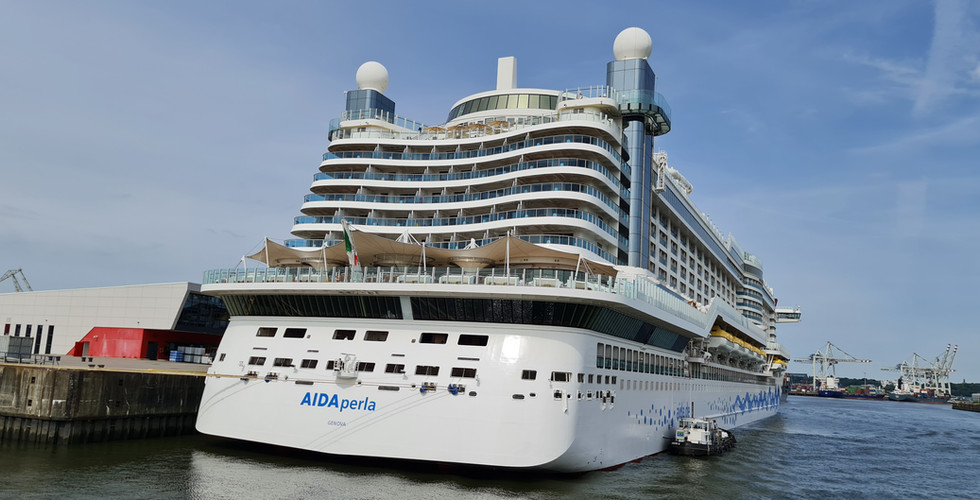




































































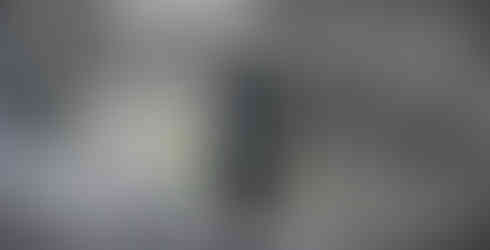




































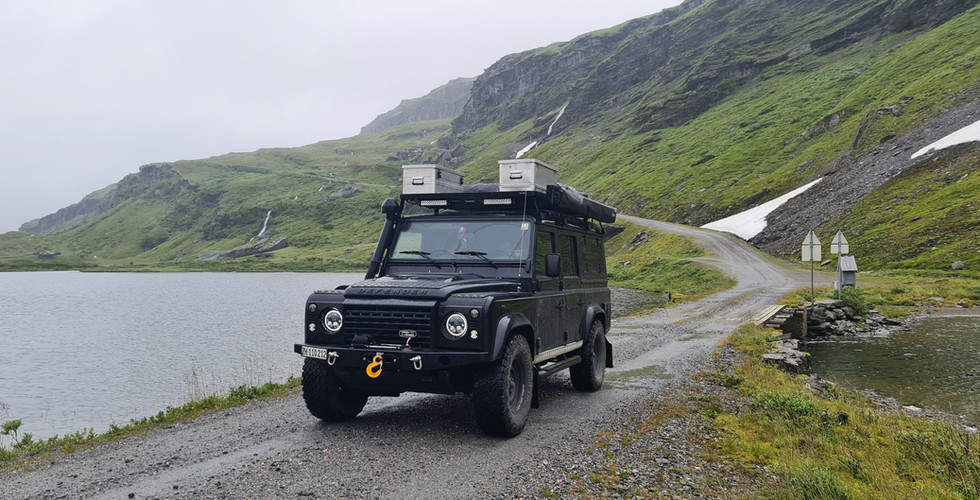



















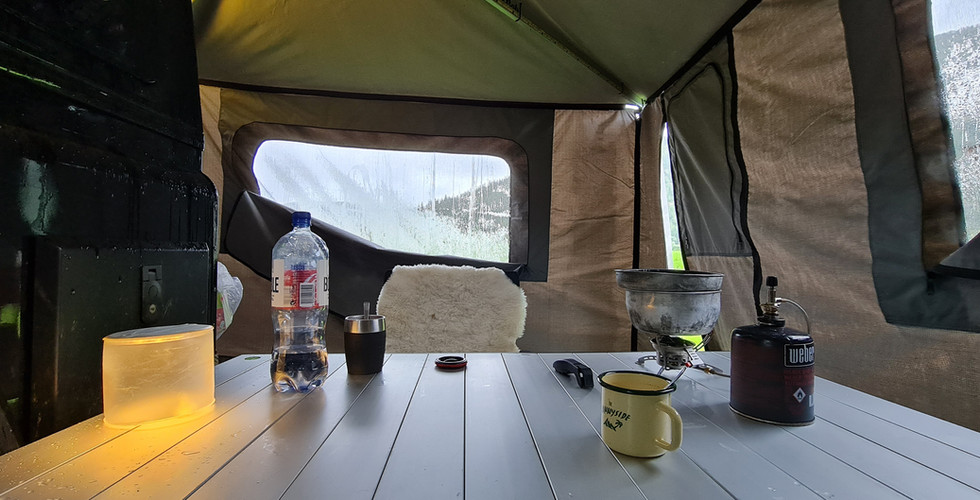



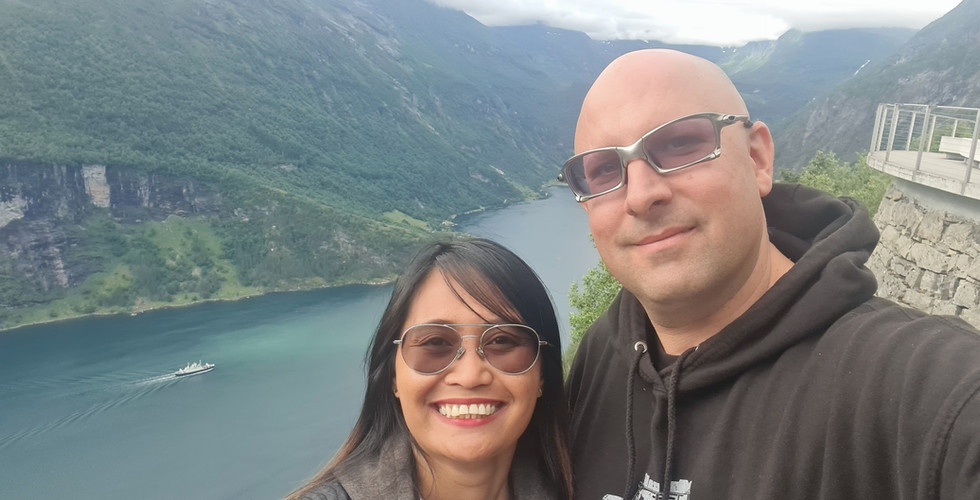





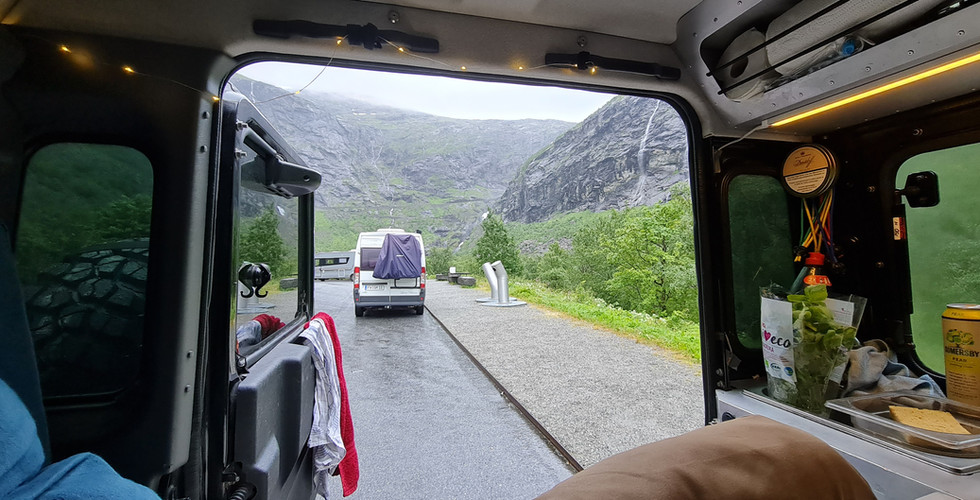
















































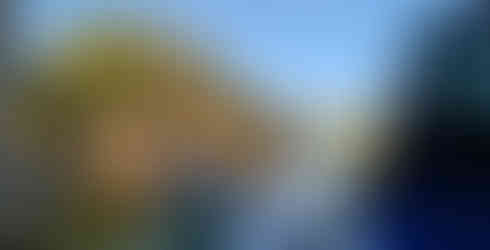





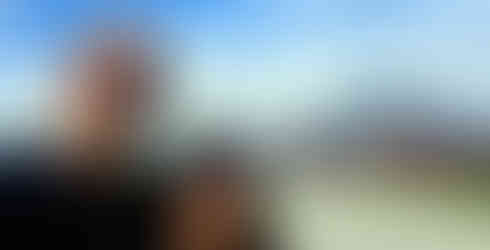































































































Comentários